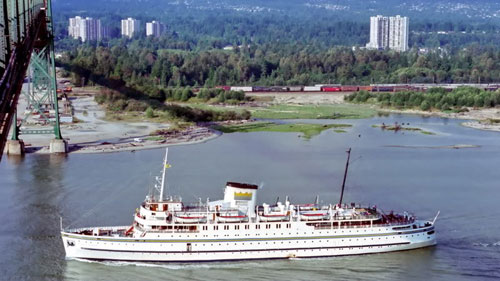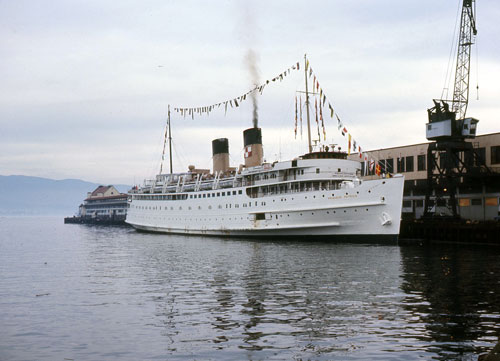
‘Pat’ and ‘George’ were the Prince and Princess of the Alaska Cruise Industry By DAVE KIFFER May 23, 2011
There were only – for the most part, the small Canadian liners, the Prince George and the Princess Pat. Both ships are long gone, although the name of one echoes on in the most famous cruise line in the world. The Prince George was actually the second ship of its name to sail the Inside Passage. The original Prince George had been a common site in Southeast Alaska for more than 30 years when it burned in a spectacular fire at the Ketchikan docks in 1945 (See The Burning of the SS Prince George, SITNEWS, Sept. 20, 2010). The second Prince George would be a familiar visitor for another 30 years, beginning in 1948. The largest ship ever built in Canada at the time, it was built for $3 million at the Esquimalt Shipyard in Victoria, from a design by Vancouver naval architect W. D. McLaren. The new Prince George was 335 feet long, with a depth of 24 feet. It weighed 5,812 tons and had a single funnel, powered by two 12 cylinder Uniflow engines to a speed of 15.5 knots. There was room for 368 passengers.
SS Prince George, under the Lions Gate Bridge in Vancouver, CA
“The career of the Prince George was uneventful and she built up a reputation for regularity and comfort,” Canadian author Norman Hacking wrote in his 1995 book “Prince Ships of Northern BC.” “In the spring of 1975, she was 28 years old, expensive to operate. In the spring of that year the company announced officially that she would be withdrawn from service at the end of that season.” But prior to the start of her last season, there was a fire onboard while she was docked in Vancouver that caused $400,000 damage. Canadian National put the ship up for sale and it was purchased for $230,000 by the British Columbia Steamship Company, which was owned by the provincial government. The plan was to operate the ship during the 1976 summer season but then the provincial government changed and the ship was sold instead to Wong Brothers Enterprises of Nanaimo, BC for $325,000, which planned to use the ship as a floating restaurant and convention center. She was towed to Nanaimo in May of 1976, where she lay idle for some time. Hacking wrote that ship was temporarily used as management headquarters during a pulp mill strike in Port Angeles and was then sold to Yong Management in Vancouver in early 1979. Several months later, the ship was towed to Portland, Oregon where it was purchased by Luka Holdings. Two years later, that company defaulted on its payments and the ship was towed back to Vancouver, according to Hacking and registered again to the Wong Brothers. They announced a $4 million plan to refit the ship and put back on the 1981 Alaska run, but only ended up spending $495,000 according to Hacking. It did operate most of the Alaskan season but not without incident. Its first voyage out of Vancouver ended quickly when the aging engines broke down in the Gulf Islands. Twice during the season it was cited for making excessive black smoke in Juneau. In 1982, the Canadian Cruise Lines syndicate began to operate the ship, but the black cloud – mechanically and financially – followed the ship and she was seized by the Continental Bank of Canada and laid up before the end of the season. In 1985, Ponderosa Ventures purchased the ship and then it was sold to Southport Associates. During the Vancouver Expo of 1986, both the Prince George and the Princess Patricia were used to house expo visitors. In 1988, the ship was seized again by the Canadian government because of $10,000 in unpaid moorage fees. It did have one final job left. Unicorn Enterprises purchased the vessel in May of 1989 and towed it to Valdez to be used as a crew ship for the workers who were cleaning up the Exxon Valdez oil spill. She was taken back to Vancouver in November of that year and plans to turn the ship into a floating mining museum were announced. They came to naught and the vessel stayed a berth in Howe Sound for several years. Finally, there was another serious fire on board the ship in 1995 and the vessel was sold for scrap to a Chinese firm. She was being towed to China when she sank in Unimak Pass on October 25, 1996. The Princess Patricia was also the second ship of its name to be on the North Coast run. The original Princess Patricia was built in Scotland, in 1902 as the Queen Alexandra and operated on the River Clyde, She was purchased by Canadian Pacific in 1911, renamed the Princess Patricia and put on the Vancouver to Nanaimo run primarily because – as the first turbine powered vessel in the Northwest, she could speed – at more than 21 knots – back and forth across Straits of Georgia in just over two hours, according to Robert Turner in his 1977 book “The Pacific Princesses.”
S.S. Princess Patricia on her first Princess Cruise - docked in San Francisco - heading south to Los Angeles.
After World War II, there was a sea change in the Inside Passage shipping industry. The Canadian National and Canadian Pacific lines, as well as the dominant Alaska Steamship line were experiencing significant challenges as barge traffic began to replace steamers as the method of choice for shipping products and supplies up the coast. The boom in the air transport industry after the war also had an effect as more and more people traveling between Puget Sound and Alaska began to fly. The War had also pretty much eliminated the slowly growing tourism industry and it would be nearly a decade before it started to come back. The Canadian National line saw its multi-ship fleet as aging and uneconomical and it responded with the new Prince George, which was geared more toward the excursion and the summer tourism trade. The Canadian Pacific countered with a new Princess Patricia that – although it would also be able to carry vehicles – would also steer away from steamship service and head more toward excursions. The new Princess Patricia was built in by Fairfield in Scotland in 1948 and was a 5,911 ton ship carrying 90 passengers in 49 cabins and 2,000 day passengers along with 50-60 automobiles. Speed was 23.5 knots by turbo-electric propulsion. The Princess Patricia was christened by Lady Patricia "Patsy" Ramsay, the former Princess Patricia of Connaught, granddaughter of Queen Victoria. Initially, the Princess Patricia was assigned to what was commonly called the “Triangle Route” between Seattle, Victoria and Vancouver. It stayed on that route for more than decade, while older CPR ships continued to service the northern British Columbia and the Southeast Alaska route. But then in May, 1958, the Canadian Pacific Railway was struck by the Seaman’s International Union. As the strike dragged on into the summer, the tourism industry on Vancouver Island collapsed. Then another union struck the ferry line between Washington State and Vancouver Island, effectively cutting the island off. Although the Canadian government stepped in to end the strike, it became clear that it was time for another option and the provincial government announced that it would begin to develop a provincial ferry system. It would be several years before the system would fully operational and CPR and CN continued to operate steamships on the Triangle Route and elsewhere, but the end of the line for most CPR steamer operations in British Columbia was in sight. What did continue was the excursion summer runs north to Alaska and in the early 1960s, CPR took the Princess Patricia out of service and converted her from essentially a day boat into an excursion steamer where it replaced the nearly 40 year old Princess Louise. And in that form, it continued to ply the Inside Passage for nearly 20 more years on its $500, eight day excursions. In 1977, the Princess Pat became embroiled in what was called the “Ambush at Douglas Channel.” In those years, there was a serious proposal that Prudhoe Bay oil should be transported by tanker from Valdez to the British Columbia coast and then shipped via pipeline to the rest of North America. One of the likely locations for the BC port was Kitimat, just south of Prince Rupert. BC environmentalists – with the help of Greenpeace – opposed the plan and that led to the “Ambush” which took place in May of 1977. Rod Marining organized the blockade at the mouth of Douglas Channel near the Hartley Bay First Nations reservation. More than forty boats took part, representing the Fishermen’s Union, Native groups, the United Church and others. Their job was to block the Princess Patricia which had been chartered by the Kitimat Pipeline Company. On board the Pat were 250 mayors, councilors, aides, oil executives and media members. The ship was hosting the North Central Municipal Mayors Conference. A maritime melee then occurred as dozens of boats, skiffs and other crafts swirled around the cruise ship in an attempt to prevent it from reaching Kitimat. Marining later claimed that the zodiac he was riding in was sucked under by the Princess Pat’s propellers and the resulting media attention - including live Canadian Broadcasting Corporation coverage – prevented the cruise ship from reaching Kitimat and eventually doomed the plan to bring supertankers into Kitimat. In May 1978, a reporter for the Ketchikan based Southeastern Log took one of the last rides on the Princess Patricia. “The thirty-year-old Princess Pat is smaller than the others which cruise Southeast’s waters,” Yvette Wixon wrote. “Hardwood walls and decks are a reminder of the ship’s age. There is a reminiscing among passengers who wonder what it was like traveling the Pat when she was a young ship.” Wixon interviewed crew members, some of whom had been with the Princess Pat for more than two decades. For example, boat store keeper Kathy O’Sullivan had been on the ship for more than 22 years. “I never get tired of my work,” she told Wixon, noting she meets 300 new people each week. Princess Pat Captain J. Raymond Hudson told Wixon that the primary reason the ship was coming out of service was environmental pollution act regulations for waste water tanks that would cost more than a $1 million for the ship. At the time, local tourism developer Len Laurance told Wixon that Canadian Pacific was hoping to purchase a newer ship to continue the service. But that didn’t come about. The Princess Pat would continue its Alaskan run until October, 1978, when in the face of competition from larger newer ships, she was “retired.” Like the Prince George, she served as a hotel ship for the 1986 Vancouver Expo and several proposals were announced to turn her into a “restaurant” ship, but none came to fruition. Eventually she was sold to a Taiwan company to become a ferry in Macao, but once again her age and the fact she was expensive to operate compared to newer ships worked against her. In 1995, she was scrapped. But a piece of the Princess Patricia still lingers along the Inside Passage. In the early 1960s, an entrepreneur named Harvey McDonald leased the Princess Patricia to provide three-day cruises between Los Angeles and Mexico. The cruises were a success and McDonald eventually purchased his own ships. In honor of the Princess ‘Pat,’ he named his cruise line Princess Cruises.
On the Web:
Contact Dave at dave@sitnews.us
Publish A Letter in SitNews Read Letters/Opinions
|
||

